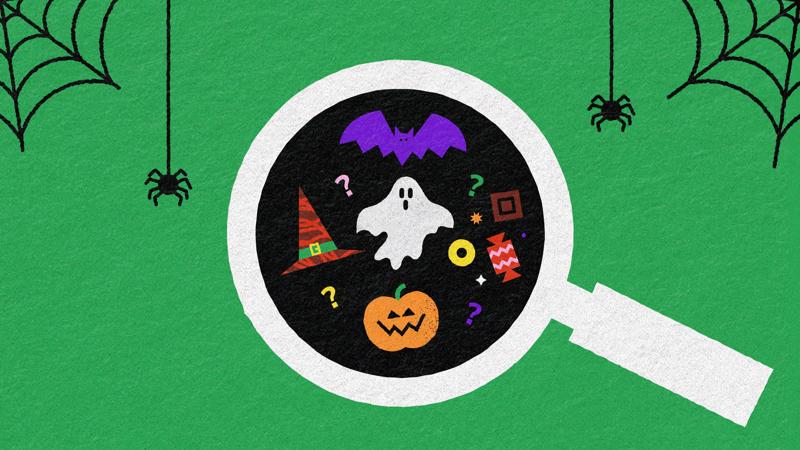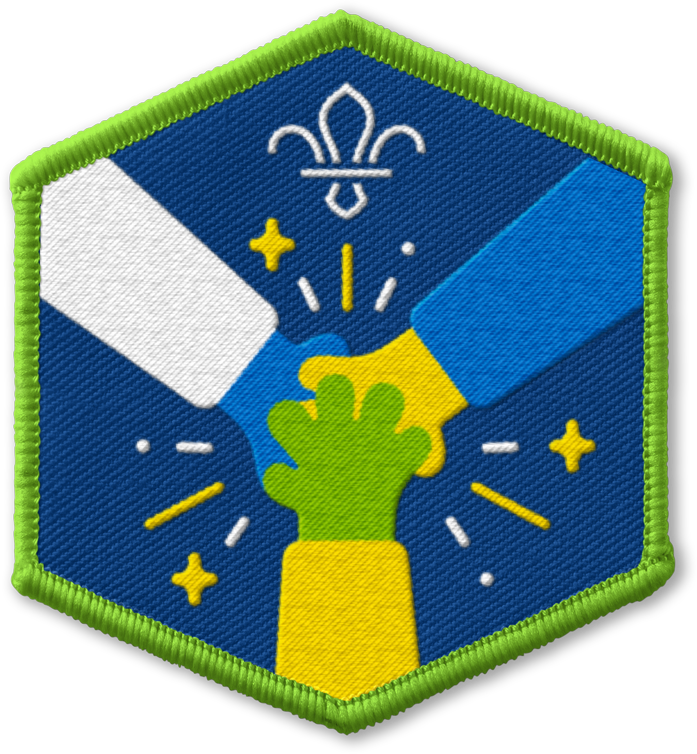
Go on a spooky scavenger hunt
You’ll need
- Something to mark lines (for example, chalk, masking tape, or rope)
- Lots of spooky items
- Device to play music (optional)
Here are some ideas for items for your treasure hunt:
- Toy bat
- Witch’s hat
- Pumpkin
- Broomstick
- Vampire teeth
- Toy ghost
- Cauldron
- Fake eyeballs
- Toy spiders
Halloween’s celebrated on 31 October every year in many countries around the world.
The word ‘Halloween’ comes from ‘All Hallows’ Eve’.
In Christianity, this’s the day before All Hallows’ Day, also known as All Saints’ Day, on the 1 November.
However, its traditions can be traced back to a festival called Samhain, pronounced Sow-in.
Samhain was first celebrated by the Celts of ancient Europe, around 2000 years ago, to mark the end of the harvest season and beginning of winter.
People believe that at this time of year that the barrier or veil between our physical world and the world of ghosts and spirits is at its thinnest.
It’s believed that this means the ghosts and spirits can move easily between the two realms and enter into our world, but there are practices and rituals to scare away the ghosts and spirits.
You can find out more about where some of today’s Halloween traditions may come from with CBBC’s Newsround Halloween traditions video.
Before you begin
- Use the safety checklist to help you plan and risk assess your activity. There's also more guidance to help you carry out your risk assessment, including examples.
- Make sure all young people and adults involved in the activity know how to take part safely.
- Make sure you’ll have enough adult helpers. You may need some parents and carers to help.
Planning and setting up this activity
- Hide a variety of spooky items around your meeting space. You can find some ideas on this page. Make sure to hide items in places that are safe and accessible for everyone, such as at varied heights.
- If you’re using masking tape to mark out the bases, you might want to do this before the session.
- The decision of whether a Scout section should run a Halloween-themed meeting is left to the local volunteers to decide. We realise that Halloween can raise issues for some people or venues, however we also recognise that it's a tradition that lots of young people are used to celebrating. Therefore, we think that only the local volunteers can judge what is most suitable for people in their group.
Find the spooky treasure
- Gather everyone together and ask everyone to get into small teams.
- Each team should have a base marked out, such as with a hoop or masking tape.
- An adult should make sure everyone understands any specific safety arrangements for the activity. For example:
- Does the space you’re using have any hazards people need to be aware of?
- Are there boundaries on how far people can go? It’s especially important to set boundaries if you’re doing this activity outdoors.
- Are there any places that are out of bounds and shouldn’t be searched, such as electrical cabinets, cleaning cupboard or storage cupboards?
- Are there are risks of things falling or being knocked, such as stacks of chairs?
- Do you need to remind people not to climb?
- Teams need to search for the spooky items hidden around the meeting place. When they find an item, they should bring the item back to their team’s base.
- You could have a golden item that‘s worth five points.
- Tell people they can only carry one item at a time, so must take an item back to the base, then go out searching again.
- You could give teams a set amount of time to find as many items as possible, or you can continue playing until all the items have been found.
- Once time is up, gather back together. What did everyone find? Teams can explore each other’s spooky treasure.
- The team who finds the most could be the winners. You could also give out prizes for teamwork and communication, too.
Reflection
This activity gave everyone the opportunity to work as a team and be active whilst looking for the spooky treasure. How much treasure did you find? Were they all easy to find or some more challenging? You all had to work together as a team to find as much as you could. How did you all work together? Did you come up with a plan of places to search? Would you change your plan if you were to do this activity again?
Safety
All activities must be safely managed. You must complete a thorough risk assessment and take appropriate steps to reduce risk. Use the safety checklist to help you plan and risk assess your activity. Always get approval for the activity, and have suitable supervision and an InTouch process.
- Active games
The game area should be free of hazards. Explain the rules of the game clearly and have a clear way to communicate that the game must stop when needed. Take a look at our guidance on running active games safely.
- Outdoor activities
You must have permission to use the location. Always check the weather forecast, and inform parents and carers of any change in venue.
To make this game easier or harder, change the number items you hide, the length of time people have to find items, how big the space you use is and how well you hide them.
To make the game harder, tell teams the must all travel together, such as by holding hands or holding onto each other’s shoulders. Once the person at the front has found an item, they take it back to the base, then they go to the back of the line and the next person in the line becomes the line leader and searches.
To make this game harder, use a larger outdoor area and hiding the items in places marked on a map for teams to locate. Make sure to risk assess the area, then make sure everyone knows the boundaries, any out-of-bounds areas, and a time to meet back. Each team should have means to contact an adult volunteer in the event of an emergency.
Assess the needs of your group and consider any mobility issues when deciding where to hide your items. Make sure everyone will be able to access them.
All Scout activities should be inclusive and accessible.
This activity could be part of a bigger spooky or Halloween-themed event or camp.


